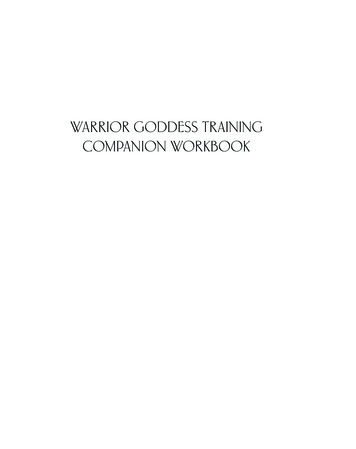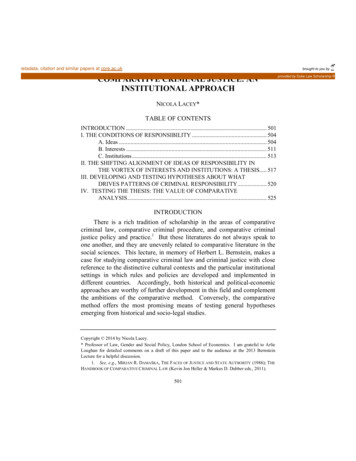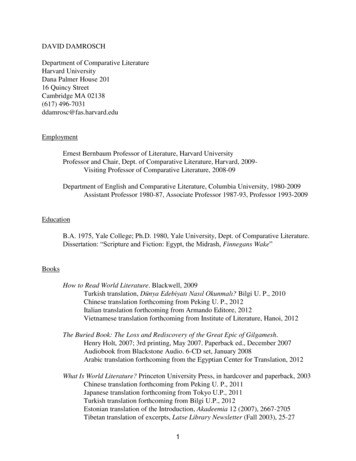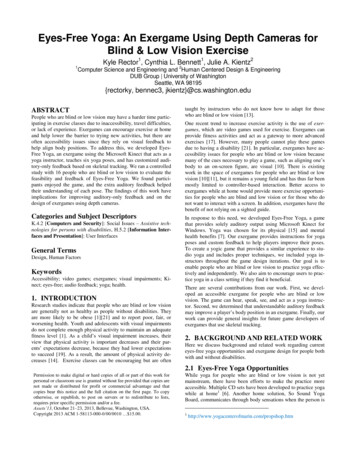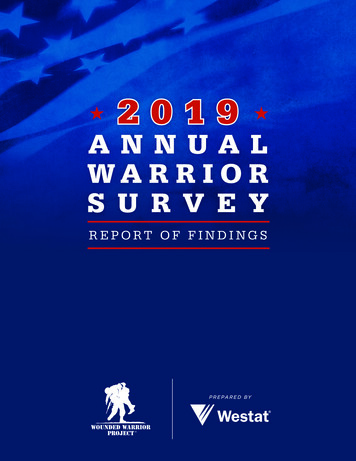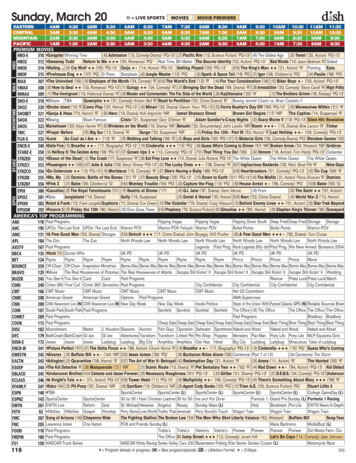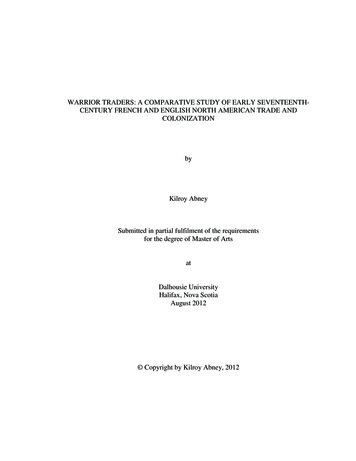
Transcription
WARRIOR TRADERS: A COMPARATIVE STUDY OF EARLY SEVENTEENTHCENTURY FRENCH AND ENGLISH NORTH AMERICAN TRADE ANDCOLONIZATIONbyKilroy AbneySubmitted in partial fulfilment of the requirementsfor the degree of Master of ArtsatDalhousie UniversityHalifax, Nova ScotiaAugust 2012 Copyright by Kilroy Abney, 2012
DALHOUSIE UNIVERSITYDEPARTMENT OF HISTORYThe undersigned hereby certify that they have read and recommend to the Faculty ofGraduate Studies for acceptance a thesis entitled “WARRIOR TRADERS: ACOMPARATIVE STUDY OF EARLY SEVENTEENTH-CENTURY FRENCH ANDENGLISH NORTH AMERICAN TRADE AND COLONIZATION” by Kilroy Abney inpartial fulfilment of the requirements for the degree of Master of Arts.Dated:August 10, 2012Supervisor:Readers:ŝŝ
DALHOUSIE UNIVERSITYDATE:August 10, 2012AUTHOR:Kilroy AbneyTITLE:WARRIOR TRADERS: A COMPARATIVE STUDY OF EARLYSEVENTEENTH-CENTURY FRENCH AND ENGLISH NORTHAMERICAN TRADE AND COLONIZATIONDEPARTMENT OR SCHOOL:DEGREE:MADepartment of HistoryCONVOCATION: OctoberYEAR:2012Permission is herewith granted to Dalhousie University to circulate and to have copiedfor non-commercial purposes, at its discretion, the above title upon the request ofindividuals or institutions. I understand that my thesis will be electronically available tothe public.The author reserves other publication rights, and neither the thesis nor extensive extractsfrom it may be printed or otherwise reproduced without the author’s written permission.The author attests that permission has been obtained for the use of any copyrightedmaterial appearing in the thesis (other than the brief excerpts requiring only properacknowledgement in scholarly writing), and that all such use is clearly acknowledged.Signature of Author ŝŝŝ
7 %/( 2) &217(176 ABSTRACT . vLIST OF ABBREVIATIONS USED . viACKNOWLEDGEMENTS . viiCHAPTER 1: INTRODUCTION . 1CHAPTER 2: THE WESTERN TRADE, THE ENGLISH TRADE VOYAGES TONORTH AMERICA AND THE FOUNDATIONS OF THE JAMESTOWN ANDSAGADAHOC COLONIES 1602-1609 . 282.1English North American Trade Voyages and the Establishment of TradeColonies . 302.2Trade Voyage influence on the Economic Goals of Jamestown andSagadahoc . 382.3 English Perceptions of the North American Climate and Native AmericanBehaviour . 52CHAPTER 3: PORT ROYAL, JAMESTOWN, AND SAGADAHOC: THECOMPARATIVE CONTEXT OF FRENCH AND ENGLISH NORTHAMERICAN TRADE AND COLONIZATION 1580-1609 . 693.1Competitive Sixteenth and Seventeenth-Century French and English TradeVoyages . 723.2 The Economic Influence of Trade Voyages on Port Royal, Jamestown, andSagadahoc . 803.3French and English Perceptions of the North American Climate and NativeCharacteristics . 943.4The Limitations of National Unity in French and English North AmericanColonization . 104CHAPTER 4: THE ROLE OF PORT ROYAL, JAMESTOWN, ANDSAGADAHOC IN THE DEVELOPMENT OF FRENCH AND ENGLISHSEVENTEENTH-CENTURY NORTH AMERICAN NATIVE RELATIONS . 1154.1The Misrepresentation of Native Relations in Sagadahoc and Port Royal . 1174.2Conflict in Jamestown: the Limits of European Experience and Agency . 1374.3The Impact of Native Societies on French and English Colonization . 152CHAPTER 5: CONCLUSION . 174APPENDIX A Map: Natives, French, and English in North America, 1600-1609. 184APPENDIX B Glossary of Names . 185BIBLIOGRAPHY . 191ŝǀ
%675 &7 This thesis examines French and English trade voyages and trade colonies in NorthAmerican during the late sixteenth and early seventeenth centuries, and French andEnglish relations with Native Americans. The colonies of Port Royal, Jamestown, andSagadahoc included members of previous French and English trade voyages anddepended on the experience and information gained during trade voyages to formulatetheir economic objectives and colonial policies. French and English North Americanactivity was intrinsically connected in this era through a plethora of amiable andcompetitive associations. National, transnational, and regional frameworks are allnecessary in explaining Port Royal, Jamestown, and Sagadahoc. French and Englishinteraction with Native American groups during these voyages and colonies wasdistinctly similar, and the diverse cultures of the native Mi’kmaq, Eastern Abenaki,Powhatans, and Armouchiquois, rather than the divisions between French and Englishculture, were central in shaping colonist-Native relations in the seventeenth century. ǀ
/,67 2) %%5(9, 7,216 86(' Champlain Volume I-III Champlain, Samuel, Henry Percival Biggar et al. The works ofSamuel de Champlain. Volume I-III. Toronto: ChamplainSociety, 1922.DSODHeidenreich Conrad and Janet Ritch. Samuel de Champlainbefore 1604: Des Sauvages and Other Documents Related tothe Period. Toronto: McGill-Queen’s University Press, 2010.ENEVQuinn, David B, and Alison M. Quinn. The English NewEngland Voyages, 1602-1608. London: Hakluyt Society, 1983.Lescarbot Volume I-IIILescarbot, Marc, Henry Percival Biggar, and W. L. Grant.History of New France. Volume I-III. Toronto: ChamplainSociety, 1907.NAW Volume 3Quinn, David B, Alison M. Quinn, and Susan Hillier. NewAmerican World A Documentary History of North America to1612: Volume 3: English Plans for North America. TheRoanoke Voyages. New England Ventures. New York: ArnoPress, 1979.NAW Volume 5Quinn, David B, Alison M. Quinn, and Susan Hillier. NewAmerican World: A Documentary History of North America to1612: Volume 5: The Extension of Settlement in Florida,Virginia, and the Spanish Southwest. New York: Arno Press,1979.ǀŝ
&.12:/('*(0(176 First and foremost, I would like to thank my supervisor Justin Roberts for his constantfeedback and support in writing this thesis. His advice and help has been indispensible infurthering my scholarly pursuits. Jerry Bannister, Alexandra Montgomery, and NathanVanderMeulen have provided me with invaluable help and an exceptional community ofBritish Atlantic scholars in which to thrive. I would also like to express my gratitude tothe Colonial Williamsburg Foundation and the staff of the John D. Rockefellar Jr. Libraryfor their generous support and assistance during my time as a Gilder Lehrman Fellow. Iwould like to thank Jessica Stern for encouraging me to pursue this project. I am alsoindebted to Colin Mitchell for his help in formulating the preliminary direction of thisthesis during our graduate seminars. I would also like to thank Jack Crowley, JerryBannister, and Justin Roberts for serving as the readers for this thesis, and for theirinsightful comments and help.ǀŝŝ
CHAPTER 1: INTRODUCTIONϭ
In 1565 the English captain John Hawkins visited the Huguenot colony of FortCaroline along the Florida coast.1 The French and English met on friendly terms andshared provisions during Hawkins’ stay.2 The French commander René Goulaine deLaudonniere and his men were desperately low on supplies, and Hawkins offered toreturn the colonists to France.3 In the end Laudonniere purchased one of Hawkins’ shipsand provisions for the colonists’ evacuation to France on credit, and French cannons wereexchanged for two Englishmen as a mutual security.4Half a century later, in 1613 the English captain Samuel Argall attacked theFrench colony of Saint Sauveur in Acadia taking the Jesuit Father Biard and fourteenFrench captives to Jamestown.5 Argall sailed north a second time in 1613 and burned themomentarily unoccupied colony of Port Royal.6 When the French colonists returned toPort Royal, Argall met privately with their commander Biencourt.7 A French accountclaims certain Frenchmen attempted to persuade the colonists to join the English, and ananonymous English account alleges Biencourt offered to operate Port Royal under theprotection of the King of England.8 During their meeting Argall was apologeticconcerning his orders to remove the French colony and Biencourt blamed the Jesuits, 1David B. Quinn, Explorers and Colonies: America 1500-1625 (London: The Hambledon Press, 1990),268.2Marc Lescarbot, Henry Percival Biggar, and W. L. Grant, History of New France, Volume I (Toronto:Champlain Society, 1907)1153Lescarbot, Vol. I, 116; Quinn, Explorers and Colonies, 268.4Ibid.5Marc Lescarbot, Henry Percival Biggar, and W. L. Grant, History of New France, Volume III (Toronto:Champlain Society, 1914), 64-6; Pierre Biard, “Letter from Father Pierre Biard to the Reverend FatherProvincial, at Paris, January 1612,” in Auguste Carayon, 3UHPLqUH PLVVLRQ GHV -pVXLWHV DX &DQDGD /HWWUHV HW GRFXPHQWV LQpGLWV (Paris: L'ecureux Libraire, 1864), 5-12.6Ibid.7Jean de Biencourt de Poutrincourt, “Complaint made before the Judge of the Admiralty of Guienne, June18th 1614,” in Lescarbot, Vol. III, 70.8Jean de Biencourt de Poutrincourt, “Poutrincourt’s Letter to Marc Lescarbot, 1614,” in Lescarbot, Vol.III, 67; “Briefe intelligence from Virginia by Letters, a supplement of French-Virginian Occurrants,” inSamuel Purchas, Hakluytus Posthumus or Purchas His Pilgrimes, Volume XIX (Glasgow: MacMillan andCo.,1891), 214-16.Ϯ
including Father Biard, rather than the English for his dire situation.9 In the end Argallleft Biencourt and his colonists at Port Royal without supplies, warning Biencourt that ifthey were found there again they would be considered enemies.10French and English colonial relations had undergone a drastic change as thesixteenth-century cooperation between French and English Protestants gave way toimperial competition over the contested coastline of northeastern North America in theearly seventeenth century. Despite this transformation, the imperial competition whichmarked Argall and Biencourt’s meeting remained relatively restrained, and this imperialrivalry coexisted with contention among French factions and transnational interactionbetween the French and English colonists. French and English North American activityremained closely linked in the time between Hawkins’ meeting with Laudonniere andArgall’s meeting with Biencourt.In the early seventeenth century, France and England underwent a simultaneoustransition from seasonal North American trade voyages to colonies intended to combinetrade with territorial possession. The three colonies of Port Royal, Jamestown, andSagadahoc all included previous members of French and English trade voyages anddepended on the information gained during these trade voyages to formulate theireconomic objectives and colonial policies. The interconnected nature of the French andEnglish establishment of trade colonies in the early seventeenth century has beenunderappreciated and understudied by scholars addressing the colonies of Port Royal, 910Ibid.Ibid.ϯ
Jamestown, and Sagadahoc.11 The imperial competition between France and England inthe early seventeenth century coexisted with transnational connections between theFrench and English and regional divisions within these groups. In highlighting thesimilarities and connections between French and English colonization efforts, this studychallenges the scholarship’s divide of French and English Native-relations in these threecolonies, and instead stresses the influence of Native societies and actions on formingcolonist-Native relations in Port Royal, Jamestown, and Sagadahoc.Scholars using macro scopes often differentiate between Iberian and NorthernEuropean efforts to colonize the Americas in the sixteenth and seventeenth centuries.12Spain and Portugal divided the extra-European world in the 1494 Treaty of Tordesillas.Spain grew rich off its American silver mines of Potosí and Zacatecas in the sixteenthcentury, and used this vast wealth to pursue a universal monarchy in Europe.13 The risingpower of Spain created anti-Spanish solidarity among England, France, and the UnitedProvidences as the Spanish monarchy claimed the Portuguese throne in 1580, defeatedthe French corsair fleet in 1582, attempted to squash the Protestant Dutch rebellion, andsent the Spanish Armada against England in 1588.14 The commonality of the Spanish 11David B. Quinn, North America from Earliest Discovery to First Settlements: The Norse Voyages to1612 (New York: Harper & Row, 1977), 443-445; Karen O. Kupperman, The Jamestown Project(Cambridge: Belknap Press, 2007), 190, 168; Helen C. Rountree, and E. Randolph Turner, Before andAfter Jamestown Virginia's Powhatans and Their Predecessors (Gainesville: University Press of Florida,2002), 51-54; April L. Hatfield, Atlantic Virginia: Intercolonial Relations in the Seventeenth Century(Philadelphia: University of Pennsylvania Press, 2004), 1-8; Marcel Trudel, Histoire De La NouvelleFrance: II Le Comptoir 1604-1627, Volume II (Montreal: Fides, 1966), 2, 19-21, 43, 58; Henry PercivalBiggar, The Early Trading Companies of New France: A Contribution to the History of Commerce andDiscovery in North America (New York: Argonaut Press, 1965), 24, 38-9, 45, 63. 12Wim Klooster, “The Northern European Atlantic World,” in Nicholas Canny and Philip Morgan eds.,The Oxford Handbook of The Atlantic World (Oxford: Oxford University Press, 2011), 165-168.13J.H. Elliott, Empires of the Atlantic World: Britain and Spain in America 1492-1830 (New Haven: YaleUniversity Press, 2006), 23.ϰ
enemy is clear in the English, French, and United Providence’s alliance against Spain inthe 1596 Treaty of The Hague.15 The Northern Europeans challenged Spanish power inthe Americas through plundering Spain’s colonies and treasure fleets and attempting torepeat their discoveries of mineral wealth in the Americas.16The similarities between the French and English colonization efforts in theAmericas in the second half of the sixteenth century and the early seventeenth centurywere substantial. Both countries sponsored repeated attempts at colonization to challengeIberian power in the Americas through the establishment of fortified bases. Bases such asEnglish Roanoke and French Charles Fort, located on the coast of the Carolinas, wereintended to claim land and serve as refitting and resupply bases to allow their privateerfleets to operate year round in the Caribbean against the Spanish colonies and treasureships. These were not just superficial similarities. Protestant Huguenot merchants had astrong presence in France’s port cities, and were central to France’s Americanenterprises.17 These Huguenots maintained close ties to England through a mixture ofmutual support and economic competition. The English and Huguenots also cooperatedin North American colonization efforts.18 The English dispatched a five-ship resupplyfleet to support the Huguenot colony of Charles Fort, and provided help to the 14Penry Williams, The Later Tudors: England, 1547-1603 (Oxford: Clarendon Press, 1995), 283-4; PhilipBoucher, “Revisioning the ‘French Atlantic’: or. How to Think about the French Presence in the Atlantic1550-1625,” in Peter Mancall ed., The Atlantic World and Virginia, 1550-1624 (Chapel Hill: OmohundroInstitute of Early American history and Culture, 2007), 293-4; For discussion of the Spanish Armada see,Garrett Mattingly, The Armada (Boston: Houghton Mifflin, 1959).15Thomas Benjamin, The Atlantic World: Europeans, Africans, Indians and Their Shared History, 14001900 (Cambridge: Cambridge University Press, 2009), 235.16Ibid., 215.17Benjamin, The Atlantic World, 227; Boucher, “Revisioning the ‘French Atlantic,” in Mancall ed., TheAtlantic World and Virginia, 277.18Robert Knecht, The French Civil Wars 1562-1598 (New York: Pearson Education, 2000), 256-260.ϱ
beleaguered Huguenot colony of Fort Caroline.19 Despite this cooperation, England andFrance increasingly became direct competitors in North America due to political changesin Europe.During the French religious civil war of 1585-1598, Queen Elizabeth became astaunch ally of Henri, the Huguenot King of Navarre and claimant to the French throne.Following the defeat of the Spanish Armada in 1588 the English became directlyinvolved in the French civil war in 1589, sending an army of 5,200 to relieve the port cityof Dieppe in Normandy.20 In 1590 England expanded their involvement, sending 4,000soldiers to Brittany, and launched a joint attack on the city of Rouen with Henri.21Despite English support, the war remained a stalemate. In 1593 Henri converted toCatholicism to end this stalemate and secure the French throne.22 Henri’s conversion andthe French peace agreement with Spain in 1598 would end this era of close ties betweenEngland and France. The English no longer trusted the now Catholic Henri.23 Theacceptance of a former Huguenot as king and the 1598 Edict of Nantes began an era ofreligious coexistence in France, binding the Huguenots to the French monarchy andending their cooperative relationship with England.24 France and England would continue 19Kupperman, The Jamestown Project, 45; Boucher, “Revisioning the ‘French Atlantic,” 288.Knecht, The French Wars of Religion, 241.21Ibid., 257-260.22Ibid., 264, 269.23Ibid., 27424Ibid., 274-5; David B. Quinn, England and the Discovery of America, 1481-1620, From the BristolVoyages of the Fifteenth Century to the Pilgrim Settlement at Plymouth: the Exploration, Exploitation,and Trial-and-Error Colonization of North America by the English (New York: Knopf, 1974),403;Griffiths, From Migrant to Acadian, 4. This situation in France was relatively short lived, and after theassassination of Henri in 1610 the religious peace and the Huguenots’ loyalty to the crown both began todeteriorate. See, Elizabeth Jones, Gentlemen and Jesuits: Quests for Glory and Adventure in the EarlyDays of New France (Toronto: University of Toronto Press, 1986), 155; Boucher, “Revisioning the‘French Atlantic,” in Mancall ed., The Atlantic World and Virginia, 289-9.20ϲ
to exploit North America through trade voyages in the early seventeenth century, butincreasingly as rivals.France and England were undergoing expansion in the early seventeenth century.France had its sights on absorbing Northern Italy, and continued to focus on SouthAmerican colonization with 1,300 settlers in St. Louis, Brazil in 1613.25 England washeavily invested in the subjugation and colonization of Ireland and commercial expansionin the Mediterranean and Far East.26 North America trade and colonization was asecondary focus of the French and English, but was of considerable importance in Franceand England’s competition with each other and in their attempts to imitate Spain’sAmerican empire.Beyond the contemporary importance of French and English activity in NorthAmerica, France and England’s North American trade and colonization efforts in theearly seventeenth century provide an important opportunity to conduct a comparativestudy of simultaneous colonization efforts. The French colony of Port Royal Acadia wasfounded in 1604, and in 1607 English colonists founded Jamestown and Sagadahoc inVirginia.27 These colonies mark the beginning of France and England’s continuousinvolvement in North American colonization; a comparative perspective of these coloniesprovides insight into the larger development of France and England’s North Americancolonies. This thesis focuses on the era beginning with the French revival of NorthAmerican trade voyages in 1598 and ending with the second charter of Jamestown in 25Ibid., 301.Nicholas Canny, Making Ireland British: 1580-1650 (Oxford: Oxford University Press, 2001), 165;Andrew Hadfield, “Irish Colonies and the Americas,” in Robert and John W. Sweet eds., Envisioning anEnglish Empire (Philadelphia: University of Pennsylvania Press, 2005), 174.27Jones, Gentlemen and Jesuits, I-II.26ϳ
1609. This timeframe allows for the careful consideration of the complex context of thistransformative era in French and English North American activity.Within this thesis the term North America is used as a geographic category whichincludes the regions of New France, Acadia, and Virginia that extended along the coast ofthe North American mainland from the Gulf of St. Lawrence to the northern limits ofSpanish Florida. Acadia and the north of Virginia were divided from Jamestown in thesouthern part of Virginia by the use of different transatlantic routes, but the Englishconceptualized Virginia as a coherent whole and the geographic overlap betweennorthern Virginia and Acadia allows these areas to be considered jointly. This thesis usesthe term colonies rather than the term settlements to refer to Port Royal, Jamestown, andSagadahoc to avoid confusion with the settlement interpretation of English colonizationwhich stresses agriculture and large-scale migration over trade. Similarly, while thisthesis will distinguish between colonies and voyages it is important to note that colonieswere dependant on transatlantic resupply voyages and had a strong focus on coastal tradeand exploration voyages. Trade voyages also continued to operate independently fromcolonies in the Caribbean and the Newfoundland fishery.Chapters Two and Three utilize French sources in English translation. Directquotations of French sources are presented in English within the text, and the originalFrench text is provided in the footnotes. In each case this study consulted the originalFrench text with the use of the University of Chicago’s French dictionary, the ARTFLProject Dictionnaires d'autrefois. This study also utilized translator’s notes and secondaryliterature relating to major French sources including the works of Samuel de Champlainand Marc Lescarbot. Throughout this study the many interpretive limitations relating toϴ
using these works in translation are recognized, and no literary analysis is attemptedwithout the support of secondary sources. Any study working in the late sixteenth andearly seventeenth centuries will encounter interpretive difficulties in the primary sourcerecord including authors’ errors and misinterpretations, biases relating to documents’purposes, incomplete source material, and sources in French and English inevitablypossess debatable meaning in certain instances. Chapter Four uses European accounts to discuss Native groups including thePowhatans of Virginia and Mi’kmaq of Acadia. This study considers the context in whichthese sources were produced and the motivations and possible biases of the authors, butultimately these European sources have limitations in demonstrating the perspective ofNative groups. The difficulty in demonstrating Native agency through European sourcesis reduced through the use of a comparative scope utilizing multiple French and Englishsources describing colonists’ interactions with the same Native groups including theMi’kmaq, Eastern Abenaki, and Armouchiquois. Archaeological and anthropologicalscholarship is consulted to help determine the culture and social structures of theseNative groups. Despite these various means of circumventing the biases and limits ofEuropean sources, determining the perspectives of Native groups necessarily requires ahigh degree of inference. In attempting to determine Natives’ perspectives this study willfully consider the context presented by the primary source material and existing scholarlyinterpretations of these Natives’ actions.ϵ
In 1606, King James I of England and his ministers issued a royal charter creatingthe dual Virginia Companies.28 The First Company based in London was to establish acolony in the southern half of Virginia, while the Second Company based in Plymouthand representing the West Country interests was to establish a colony in the northern halfof Virginia.29 The creation of the Virginia Companies represented a resumption of NorthAmerican colonization after a long break following the loss of Sir Walter Raleigh’ssecond colony of Roanoke in 1587. The scholarship has generally interpreted the 1607colony of Jamestown Virginia as founded on settlement, with plans for the migration of asubstantial English population and the production of agricultural crops. This perspectiveis pervasive throughout the work of David Quinn, Nicholas Canny, Edmund Morgan, andmore recently J.H. Elliott.30 This view of Virginia as a colony based on acquiring andsettling land has fallen from favour among many scholars. Alison Games argues that thesettlement model of Jamestown results from scholars’ projecting Virginia’s eventualsuccess based on Native removal and intensive agriculture onto the colony’s initial 28“The first Virginia Charter of April 10, 1606,” in David B. Quinn, Alison M. Quinn, and Susan Hillier.New American World: A Documentary History of North America to 1612: Volume 5: The Extension ofSettlement in Florida, Virginia, and the Spanish Southwest (New York: Arno Press, 1979), 191-192,(Hereinafter NAW Volume 5).29Ibid., 192.30Nicholas P. Canny, Kingdom and Colony (Baltimore: The Johns Hopkins University Press, 1988);Canny, Making Ireland British: 1580-1650, Nicholas P. Canny, The Elizabethan Conquest of Ireland: APattern Established 1565-1576 (New York: Harper &Row, 1976); J.H. Elliott, Empires of the AtlanticWorld: Britain and Spain in America 1492-1830 (New Haven: Yale University Press, 2006); Edmund S.Morgan, American Slavery American Freedom: The Ordeal of Colonial Virginia (New York: W.W.Norton & Company, 1975); David B. Quinn, The Elizabethans and the Irish (Ithica: Cornell UniversityPress, 1966).ϭϬ
foundation.31 Many scholars now view the trade model of England’s eastern venturesincluding the Levant and East India Companies as the prototype for early Virginia.32In Pursuits of Happiness, Jack Greene disputes the use of a pure settlement modelin early Virginia, and maintains that failing a conquest of local Natives on the Spanishand Irish models, the London Virginia Company attempted to operate Jamestown on themodel of the eastern trade posts used by the Levant, East India, and MuscovyCompanies.33 In Greene’s work the eastern trade model is secondary to the LondonCompany’s desire to emulate Spain’s American conquests and attempts to subdueNatives to agricultural labourers on the Irish model.34 Greene’s work represents anincreased emphasis on the commercial nature of Virginia without a completeabandonment of the settlement model in early Virginia.35 Recent scholarship with anincreased Mediterranean focus builds on Greene’s argument that early Virginia used atrade model based on eastern trade precedents.Linda Colley’s Captives: Britain, Empire and the World, stresses the importanceof the Mediterranean to England’s overseas expansion.36 Colley shows that theMediterranean was the center of England’s overseas expansion, and represented the most 31Games The Web of Empire: English Cosmopolitans in an Age of Expansion 1560-1660 (Oxford: OxfordUniversity Press, 2008), 127.32Kupperman, The Jamestown Project, 37; Games, The Web of Empire, 118-120; Joyce Chaplin, “TheBritish Atlantic.” in Nicholas Canny and Philip Morgan eds., The Oxford Handbook of The AtlanticWorld (Oxford: Oxford University Press, 2011) 220-21; Klooster, “The Northern European AtlanticWorld,” in Canny and Morgan eds., The Oxford Handbook of The Atlantic World, 167-8; Stern “BritishAsia and British Atlantic: Comparisons and Connections,” 695; Gerald MacLean and Nabil Matar, Britanand the Islamic World, 1558-1713 (Oxford: Oxford University Press, 2011), 14-16.33Jack P. Greene, Pursuits of Happiness: The Social Development of Early Modern British Colonies andthe Formation of American Culture (Chapel Hill: University of North Carolina Press, 1988) 8-9.34Ibid., 8-9.35Ibid., Edmund Morgan uses a similarly economic interpretation of early Virginia but maintains a puresettlement view of the colony. See, Morgan, American Slavery American Freedom, 77.36Linda Colley, Captives: Britain, Empire, and the World, 1600-1850 (New York: Anchor Books, 2004).ϭϭ
profitable market for England from 1600 to 1660.37 Colley argues that due to itseconomic importance the Mediterranean was key in English policy concerns during thelate sixteenth and early seventeenth centuries.38 In Karen Kupperman’s The JamestownProje
TITLE: WARRIOR TRADERS: A COMPARATIVE STUDY OF EARLY SEVENTEENTH-CENTURY FRENCH AND ENGLISH NORTH AMERICAN TRADE AND COLONIZATION DEPARTMENT OR SCHOOL: Department of History . Biggar, The Early Trading Companies of New France: A Contribution to the History of Commerce and Discovery in North America (New York: Argonaut Press, 1965), 24, .

